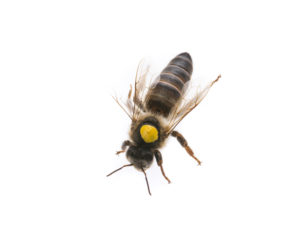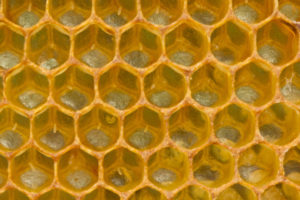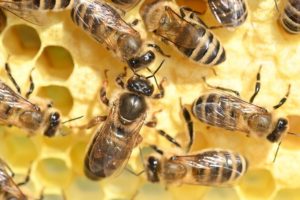The Basics of Requeening a Hive
The queen is the heartbeat and the sole bee that continues producing bees for the hive. Without a queen, a hive will quickly die. Likewise, if a queen isn’t doing her job, the hive will slowly die off if she isn’t replaced. This replacement process is often referred to as requeening. It happens both in nature and in kept hives. However, the timing and methods of requeening can vary vastly. Requeening is a simple yet complex process, and this guide takes you through the basics.

What Exactly is Requeening?
A healthy bee colony needs a queen to function properly and to continue on with new generations. Queen bees do live a lot longer than other worker bees. While a worker bee might live for a few months if it’s lucky, queen bees can live for several years. However, the beehive is a continuing work in progress. The queen lays new eggs daily, and now workers and drones hatch all the time. Because workers and drones have a drastically shorter lifespan, new generations have to come in more frequently than with queens.
However, we all know there’s only one queen in the colony. Queens do more than just produce new generations of bees in their colonies. They also emit pheromones that keep the other bees within the hive calm, reassured, and confident the queen is healthy and doing her job.
What happens when a queen stops producing enough eggs?
Queens can’t produce eggs forever. The queen bee only has a day or two to make, and these days take place early on in her life. Ideally, she can gather enough sperm to continue producing worker bees for many years. However, there are a lot of factors that can prevent this from happening. Sometimes, it’s down to genetics or species. Many times, it can also come down to environmental factors, like cold weather, storms, or anything else that prevents the queen bee from reaching the mating grounds, or from spending enough time there.

Naturally, when this happens, the queen stops producing sufficient eggs than she otherwise would. The worker bees know when their queen isn’t as productive as she once was. Her pheromones may decrease, giving the worker bees subtle signals. Or, the worker bees attending the queen will notice that she isn’t laying as many eggs as she once did.
In nature, the worker bees replace, or supersede, their present queen, and start producing larvae that grow into potential queen bees,
In an apiary, or a kept beehive, the beekeeper often takes the initiative to replace the queen before this happens. This is what we refer to as requeening.
How Often do Beekeepers Requeen Their Hives?
There’s rarely a ‘one size fits all’ approach to requeening. The time between requeening might vary depending on species, colony productivity, or even the queen in question. Some beekeepers choose to replace their queen every year. Others might wait two or three years before they replace the colony’s queen.
Commercial operations often deal with many different hives, and therefore many different queens. If a queen dies naturally, she needs to be replaced as soon as possible. To keep the ages of queens in order, commercial beekeepers often use color coded dabs of paint to indicate the month or year that the queen entered the hive.
How to Requeen a Hive
When it comes to the actual requeening, there are several different ways. However, there are a couple that beekeepers can always rely on. Of course, the method of requeening also depends on how the beekeeper gets their new queens. You can raise queen bees yourself, get them from another beekeeper, prompt your workers to raise new queens, or even purchase queens, whether online or locally.
One thing you don’t have to worry about as much when the queen passes the peak of her productivity is what to do with her when you add a new queen. Well, in some cases at least. When queens naturally start their decline, the other bees start preparing larger cells for potential queen eggs. In an apiary, you might have to approach requeening the way worker bees would if the queen were to unexpectedly die.
Next, we’ll take a look at the most common methods of requeening, and the best instances to use them in:
Natural supersedure
As you might assume, in commercial beekeeping operations this is far from the method of choice. Because you have to let nature take its course, you could also end up lessening your brood in the process. Depending on the season, and your hive, this could mean a very unproductive season, especially if your colony is already low on workers.
In nature, the worker bees attending the queen notice when she isn’t laying as many eggs as she once did. This may be down to her age, or the inability to gather enough sperm during her few mating days to last throughout her productive lifetime. If she can’t store enough sperm, the queen can only lay unfertilized eggs. Unfertilized eggs always turn into male drones. Unfortunately, drones don’t take on the other duties in the hive, such as caring for young, gathering pollen and nectar, making honey, or even attending to the queen. Hives wherein queen bees can only produce male offspring, aka drones, are considered dying hives. The reason is that with only drones in production, there isn’t even a possibility for female offspring, and therefore a queen to continue the colony.
If this happens in an apiary, it’s typically because the queen unexpectedly dies from disease, pests, or another cause.
In natural supersedure, the worker bees ‘elect’ potential queen larvae, and begin feeding them a diet of solely royal jelly.
Commercial beekeepers tend to avoid this method, as it often leads to a decrease in population and production for the following honey season.
Direct requeening (direct release)
Direct requeening works much as it sounds like. The beekeeper gets rid of the current queen. They then put a fresh queen right into the hive. Unfortunately, this is a risky process. Remember that queens release pheromones unique to their hive. These keep the other bees reassured, but they’re also a means for the other bees to distinguish their queen from any others.
The new queen produces her own pheromones, although they won’t be as strong with virgin queens. However, unfortunately for the new queen, one pheromone doesn’t immediately gain the hive’s loyalty. In fact, it can do quite the opposite. Worker bees will sense the new queen’s presence, and recognize that she isn’t yet a part of their hive. As a result, they often attack or kill her, believing her to be an intruder, and not a replacement for their former queen.
Direct requeening is less common, because the new queens often die when the hive doesn’t recognize them. Because of this, most beekeepers choose to go the indirect route of requeening.
Indirect requeening (indirect release)
Indirect requeening has a far higher success rate than requeening. Depending on your experience, and how you obtain your queens, you can choose one of two methods. In each case, you give the hive time to adjust to their new queen so that they’re more likely to accept her.
If you purchase queens, it’s easiest to use a queen cage, especially because purchased queens typically come in them. These are basically very small wire mesh boxes (or made of another similar material). They usually have one side without mesh, which beekeepers stick to the honeycomb. Others that have the design of a mailing cage don’t, although either method works.
At the bottom of the queen cage there’s a little cork that covers a candy plug. Before you put the new queen into your hive, you need to gently remove the cork layer. Be careful not to accidentally dislodge the candy plug. After you remove the cork, you need to make a small hole through the candy plug.
Note: When you make a hole in the candy plug, only use a small, sterile implement, like a pin or needle. Use caution and be gentle to avoid hurting your new queen.
Then, carefully place the queen cage either to the honeycomb, or between frames, depending on the design of your cage. The other bees will naturally gravitate to the sugar in the candy plug, and begin to eat the plug. This process can take several days. Over the coming days, the bees begin to get accustomed to their new queen, and the pheromones she releases. As the bees go about their usual duties, they begin spreading the pheromone scent to the other bees in the hive.
While the bees might eat through the candy plug within a few days, it’s best to avoid disturbing the hive. Most beekeepers recommend waiting at least a week to allow the hive to accept their new queen and ‘reorient’ themselves.
After a week, you can check your hive and pull the frames. Then, find the queen and ensure she’s healthy and being accepted by the hive.

